Jewelry design technology is defined as an interconnected mixture of overlapping circles that contain minerals, stones, and different details, and the importance of the success of designing any piece of jewelry lies in the ability to combine all these elements and details within the design crucible and its axis in a way that highlights its aesthetic and manufacturing technology.
Hence the importance of welding jewelry, it is easy to link the pieces together, but the most difficult part is the possibility of joining them without leaving traces or scars that reduce their beauty and mastery
In this article, we will learn about how to weld gold and metals and the most important convergence rules that contribute to the success of this process
Definition:
The welding process is defined as the connection between two different pieces of metal together, as it is an essential pillar for designing or repairing jewelry by creating undetectable contact between them.
- The most important techniques used
There are three basic methods used in the welding process for gold and metals:
- Engraving welding
- Welding conduction
- Laser welding
- Engraving welding
The welding process is done by heating a metal similar to the original metal, but its melting point is less than the melting point of the original metal and then directing a flame to it.
- Welding conduction
In the traditional method of jewelry welding, a flame torch is usually directed directly to the welding piece to melt it, which will cause the metal to heat, boil, and oxidize, and often the welding will be rejected stubbornly from melting in the joint, regardless of the amount of heat applied, and for this reason what has been called By “conduction welding technology” which depends on heating the original metal to a degree close to the melting temperature, then transferring this heat to a piece of welding, which is pulled to the joint by a process called capillary action “, which increases the strength of the welding force of the joint by Connect the metal properly without leaving scars or traces.
- Laser welding
The best method of welding jewelry and metals at all has the ability to produce strong weldings with a high level of accuracy, and it also saves both time and effort used in traditional methods
Laser welding is defined as a highly concentrated light beam that melts a very small area of metal and can be used to bond similar or asymmetric alloys.
Laser welding is distinguished by its high accuracy from other types of welding. It is not necessary to expose the entire metal to high temperatures by melting the metal and merging it together, as it can reach the most accurate places of the metal that the ordinary welding cannot reach, as well as the speed required to perform the Welding process, and laser welding is 43% stronger than other types of welding, in addition, laser welding does not leave any layers or marks after cleaning or finishing operations, as laser welding reconfigures the molecular structure of identical or asymmetric metals at the welding point.
These were the most important techniques used in the process of welding gold and minerals and you are free to choose between them according to your capabilities and assistive production. You can join one of our training programs to learn all the jewelry design skills in the first professional academy for designing and manufacturing jewelry in Istanbul.

